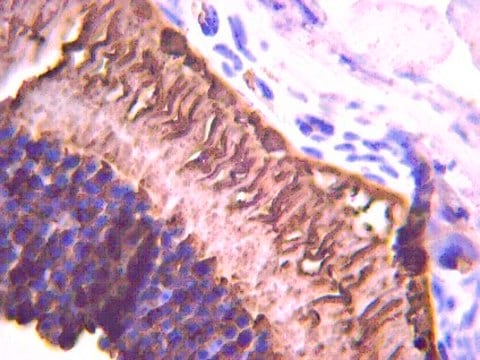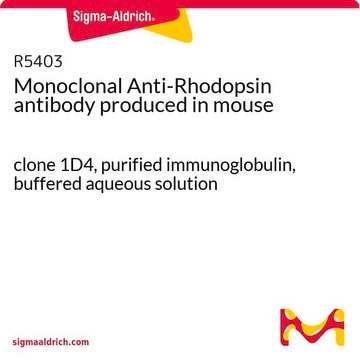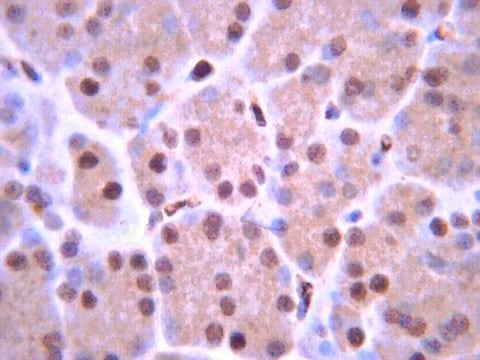AB5585
Anti-Recoverin Antibody
serum, Chemicon®
Synonym(s):
Recoverin
About This Item
Recommended Products
biological source
rabbit
antibody form
serum
antibody product type
primary antibodies
clone
polyclonal
species reactivity
human, mouse, rat, frog, chicken
manufacturer/tradename
Chemicon®
technique(s)
immunocytochemistry: suitable
immunohistochemistry (formalin-fixed, paraffin-embedded sections): suitable
western blot: suitable
NCBI accession no.
UniProt accession no.
shipped in
dry ice
target post-translational modification
unmodified
Gene Information
human ... RCVRN(5957)
mouse ... Rcvrn(19674)
General description
Specificity
Immunogen
Application
Neuroscience
Sensory & PNS
1:1,000-1:5,000 dilution using ECL.
Immunohistochemistry:
1:1,000 (2 hours at room temperature or overnight at 2-8ºC) on frozen and paraffin embedded tissue sections. Suggested fixative is 4% paraformaldehyde or 3% paraformaldehyde with 0.1% glutaraldehyde. Suggested permeabilization solution is 0.1% Triton X-100. Suggested blocking buffer is 0.05 M Tris saline, pH 7.4 containing 2.5% BSA, 0.1% triton and 0.05% sodium azide.
Optimal working dilutions must be determined by the end user.
Target description
Linkage
Physical form
Storage and Stability
Analysis Note
POSITIVE CONTROL: Recoverin is found in photoreceptors and midget cone bipolar cells in retina and pinealocytes in pineal gland.
Other Notes
Legal Information
Disclaimer
Not finding the right product?
Try our Product Selector Tool.
Storage Class Code
11 - Combustible Solids
WGK
WGK 1
Flash Point(F)
Not applicable
Flash Point(C)
Not applicable
Certificates of Analysis (COA)
Search for Certificates of Analysis (COA) by entering the products Lot/Batch Number. Lot and Batch Numbers can be found on a product’s label following the words ‘Lot’ or ‘Batch’.
Already Own This Product?
Find documentation for the products that you have recently purchased in the Document Library.
Our team of scientists has experience in all areas of research including Life Science, Material Science, Chemical Synthesis, Chromatography, Analytical and many others.
Contact Technical Service







